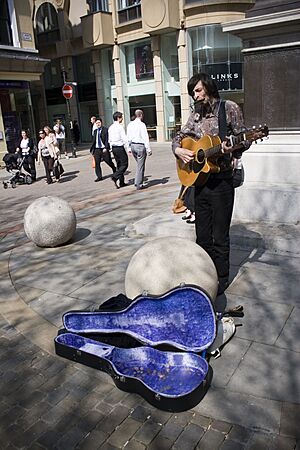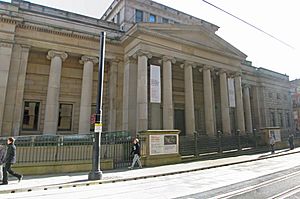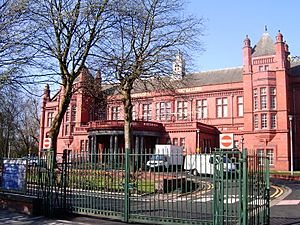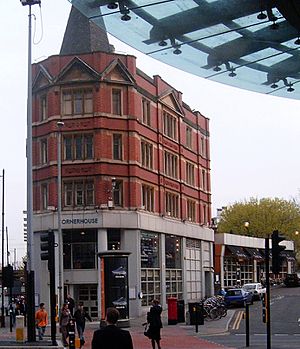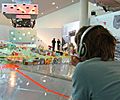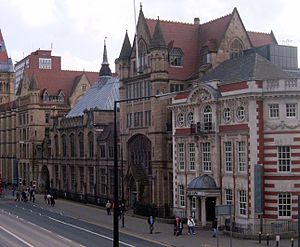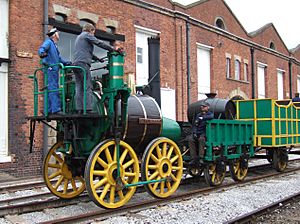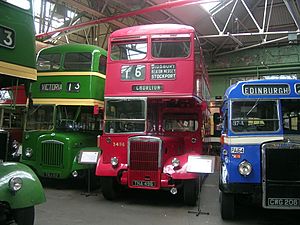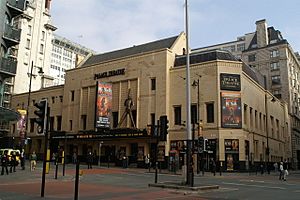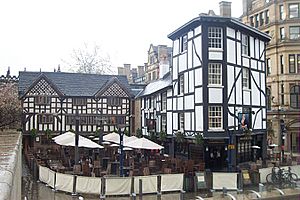Culture of Manchester facts for kids
The Culture of Manchester is really special for its art, buildings, theatre, and music. Even though it's the 5th largest city in the United Kingdom by population, many people see Manchester as the second most important city in the UK. Its exciting culture has made Manchester a very important place. This has helped the city's population grow a lot, and its universities are very popular for students.
A famous broadcaster named Brian Redhead once said that Manchester is the "capital" of the North of England. He believed it's where the modern world began. Ian Brown from the Stone Roses band also joked that "Manchester has everything except a beach."
Manchester is often called the world's first industrial city. It's the third most visited city in the United Kingdom, after London and Edinburgh. It's also a big hub for creative jobs and industries.
Contents
Art and Galleries in Manchester
In 1857, Manchester hosted the "Art Treasures of Great Britain" exhibition. It was the largest art show ever held in the UK, and maybe even the world! Over 16,000 artworks were on display. More than 1.3 million people visited, which was about four times Manchester's population back then. This exhibition helped shape how public art collections were set up in the UK.
Manchester has several great art galleries:
- Manchester Art Gallery
- Whitworth Art Gallery
- esea
- Home
- Castlefield Gallery
- Smolensky Gallery
The Manchester Art Gallery on Mosley Street has many paintings by Italian and Flemish masters. It also has a famous collection of Pre-Raphaelite paintings. These include works by Ford Madox Brown, Holman Hunt, and Rossetti. A huge Pre-Raphaelite artwork, The Manchester Murals, shows twelve paintings about the history of Manchester. Ford Madox Brown was asked to create them for the Great Hall of Manchester Town Hall in 1879. You can visit the Great Hall when there are no private events.
Manchester was very important in the textile industry. This is shown in the collections at the Whitworth Art Gallery. This gallery also displays modern art and sculptures. You can see works by Epstein, Hepworth, van Gogh, and Picasso.
Other places to see art in Manchester include the Smolensky Gallery. Home opened in 2015. It combines the exhibitions and cinemas from the old Cornerhouse and Library Theatre Company. Home shows art from both local and international artists. It also hosts the Manchester Open Exhibition every two years.
The painter L. S. Lowry was born near Manchester in Stretford. He is famous for his "matchstick" paintings of industrial Manchester and Salford. You can see his works at the Manchester Art Gallery and the Whitworth Art Gallery. The Lowry art centre in Salford Quays has a large permanent exhibition of his paintings. The French Impressionist painter Adolphe Valette lived in Manchester for a while. He painted many local scenes. The Irish sculptor John Cassidy also worked in Manchester for most of his life. He created many beautiful sculptures. The Turner Prize-winning artist Chris Ofili is from Manchester.
-
Inside the Whitworth Art Gallery
-
Work by Ford Madox Brown at Manchester Art Gallery
-
The Manchester Murals at Manchester Town Hall
-
Valette's painting of Albert Square, Manchester in 1910
-
Going to Work (1943) by L.S. Lowry in the Imperial War Museum North
Manchester's Architecture
Manchester's buildings show many different styles. You can see early 19th-century Neoclassical and Victorian buildings. There are also very modern designs. Many buildings remind us of Manchester's past as a global centre for the cotton trade. Lots of old warehouses are now used for other things. But their outside look is mostly the same. This helps the city keep its original feel.
An interesting fact about Manchester's buildings is that some were inspired by Venice. This happened during the Industrial Revolution when the city grew fast. You can find these buildings south and east of Albert Square. They are also near the 92nd lock of the Bridgewater Canal, close to the Beetham Tower.
Manchester also has many skyscrapers. Most were built in the 1960s and 1970s. But in the 21st century, people started building more tall buildings. Many new homes and offices are being built in the city centre. The Beetham Tower was finished in 2006. It has a Hilton hotel, a restaurant, and apartments. It was the tallest building in the UK outside London for a while.
Museums in Manchester
Here are some of the museums you can visit in Manchester:
- Greater Manchester Police Museum
- Manchester Jewish Museum
- Manchester Museum
- Science and Industry Museum
- Manchester Museum of Transport
- National Football Museum
- Pankhurst Centre
- People's History Museum
- Gallery of Costume
- Heaton Hall
The Manchester Museum opened in 1888. It has amazing collections in archaeology, especially Egyptology. It also has great collections in natural history, like plants, insects, and fossils.
In the Castlefield area, you can visit a rebuilt part of the Roman fort of Mamucium. Manchester's rich industrial past is celebrated at the Science and Industry Museum. This museum is also in Castlefield. It has a large collection of steam locomotives, working machines from the Industrial Revolution, aircraft, and space vehicles. It's located in the old Liverpool Road railway station. This was the end point of the world's first passenger railway. You can also learn about transport history at the Museum of Transport in Cheetham Hill. The Imperial War Museum North is a short distance from the city centre in Salford Quays.
Other museums in Manchester tell the stories of the city's people. The People's History Museum shows the history of work and politics in the city. It remembers the Peterloo Massacre. It also highlights Manchester's strong links to the Trade union movement, Women's suffrage, and football.
Manchester is a huge football city. Its football history is remembered at the home stadiums of its Premier League clubs. These are Manchester City and Manchester United. Both clubs have museums at the City of Manchester Stadium and Old Trafford football stadium.
The National Football Museum has moved to Urbis in Manchester city centre. It is now its new permanent home. This move aims to get more visitors. It's expected to attract 400,000 visitors each year.
In Cheetham Hill, the Manchester Jewish Museum shares the story of the Jewish community in Manchester. It covers their history from the Industrial Revolution to today.
Music in Manchester
In the 1600s, Manchester had "town waits." These were musicians who played music in the mornings and evenings. They also played at weddings and dinners.
In 1918, the Education Committee hired a Music Adviser for the city's schools. This person encouraged schools to form choirs and orchestras. They also promoted teaching music appreciation and how to play instruments.
C.H. Herford wrote in 1915 that "Music has been said to divide with Mammon the devotion of the people of Manchester." This means music was very important to the people of Manchester.
Classical Music in Manchester
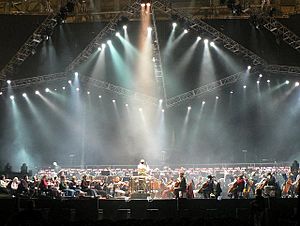
Manchester has two symphony orchestras: the Hallé and the BBC Philharmonic. There is also a chamber orchestra called the Manchester Camerata. The Gorton Philharmonic Orchestra is an amateur orchestra started in 1854. In the 1950s, Manchester was home to the 'Manchester School' of classical composers. These included Harrison Birtwistle, Peter Maxwell Davies, David Ellis, and Alexander Goehr.
Manchester is a big centre for music education. It has the Royal Northern College of Music (RNCM) and Chetham's School of Music. The RNCM was formed from two older schools: the Northern School of Music (1920) and the Royal Manchester College of Music (1893).
From the 1820s, famous singers and musicians started visiting Manchester. Franz Liszt came in 1824 and 1840. His performances were highly praised. In 1847, Felix Mendelssohn conducted his oratorio Elijah in the Free Trade Hall. In 1848, Frédéric Chopin, who was already very ill, played a concert in Manchester.
Nymphs and Shepherds
Nymphs and shepherds, come away.
In ye groves let's sport and play,
For this is Flora's holiday,
Sacred to ease and happy love,
To dancing, to music and to poetry;
Your flocks may now securely rove
Whilst you express your jollity.
Nymphs and shepherds, come away.
In 1929, the Manchester Children's Choir, with 250 members, recorded Henry Purcell's "Nymphs and Shepherds". They recorded it with the Hallé Orchestra at the Free Trade Hall. This recording was a huge success, selling over a million copies. The choir was later reunited in 1979 to celebrate its golden jubilee.
For many years, the main classical music venue was the Free Trade Hall. But since 1996, Manchester has the modern Bridgewater Hall. This concert hall has 2,500 seats and is home to the Hallé Orchestra. It's known for its excellent sound quality. Other places for classical concerts include the RNCM, the Royal Exchange Theatre, and Manchester Cathedral.
Brass Band Music
Brass band music is a big tradition in the North of England. It's an important part of Manchester's music history. Some of the UK's best bands, like the CWS (Manchester) Band and the Fairey Band, are from Manchester. The Whit Friday brass band contest happens every year in nearby areas.
Pop Music in Manchester
Manchester had a big pop music scene in the 1960s and early 1970s. Bands like The Hollies, The Bee Gees, Herman's Hermits, and 10cc came from here. A famous Sex Pistols concert in 1976 led to many important new bands forming. These included the Buzzcocks, the Smiths, and the Fall. Tony Wilson's Factory Records was a major independent music label. It was home to groups like Joy Division and New Order.
The "Madchester" music scene brought a lot of attention to the city in the late 1980s and early 1990s. Bands like the Stone Roses, Happy Mondays, the Charlatans, Inspiral Carpets, and James mixed different music styles. They combined alternative rock, psychedelic rock, and dance music. This created a unique sound that became very popular. In the 1990s, Oasis became arguably Manchester's most popular band.
The Chemical Brothers formed in Manchester. Also, former lead singers Ian Brown (from The Stone Roses) and Morrissey (from The Smiths) have had successful solo careers. Other famous musicians from the Manchester area include Richard Ashcroft (from The Verve) and Jay Kay (from Jamiroquai).
In 1965, three pop groups from Manchester had consecutive number 1 songs on the US Billboard Hot 100 chart. This was a unique achievement!
Manchester's main pop music venue is the Manchester Arena. It's next to Manchester Victoria railway station. It can hold over 21,000 people and is one of the largest indoor arenas in Europe. Other big venues include the Manchester Apollo and the Manchester Academy. Smaller places to see live music are the Band on the Wall, the Bierkeller, and the Night and Day Café.
The famous American anti-war musical Hair from the 1960s has a song called "Manchester, England."
Literature in Manchester
Early Writings
In 1659, some papers by Dr. John Dee, who was once a Warden of the Collegiate Church, were published. His diary was also published in 1842.
Richard Hollingworth, born in Manchester, wrote a history of the town called Mancuniensis in the 1600s.
18th and 19th Century Writers
The poet John Byrom was born in Manchester in 1691. He is best known for his Christmas hymn "Christians, Awake."
The first newspaper in Manchester, the Manchester Weekly Journal, started in 1719. The first book published there was a math book by John Jackson.
The Manchester Literary and Philosophical Society was founded in 1781. Its members included Peter Mark Roget (who created the thesaurus).
Samuel Bamford, a weaver and poet, was born near Manchester in 1788. He was involved in politics and wrote an autobiography called Passages in the Life of a Radical. The writer Thomas De Quincey was born in Manchester. He is famous for his Confessions of an English ... Eater. William Harrison Ainsworth (born 1805) wrote many historical novels. Some of them are about Lancashire, like The Manchester Rebels.
In the 19th century, Manchester appeared in novels about the changes from industrialisation. These included Mary Barton: a tale of Manchester life (1848) by Elizabeth Gaskell. Friedrich Engels wrote The Condition of the Working Class in England in 1844 while living in Manchester. He used his observations of working people in Manchester and Salford.
Charles Dickens is thought to have based his novel Hard Times partly on Manchester.
Charlotte Brontë started writing Jane Eyre in Manchester in 1846. She was there to take her father for eye surgery. A blue plaque marks the building where she began writing.
The novel The Manchester Man by Mrs. G. Linnaeus Banks was published in 1876. It tells the story of Jabez Clegg, the "Manchester Man." His life, from poor apprentice to wealthy master, reflects the growth of the city. The book also includes vivid accounts of the Peterloo Massacre of 1819. The heroes of the book, Jabez Clegg and Joshua Brooks, are remembered in the names of Manchester public houses.
20th and 21st Century Writers
Howard Spring, a Welsh novelist, worked as a journalist in Manchester. He set his first novel, Shabby Tiger (1934), there.
Louis Golding (born in Manchester in 1895) used his Manchester background in his novels.
The Manchester novelist Maurice Procter (born 1906) wrote early police procedural novels. His book Hell Is a City (1954) is set in a fictional Manchester.
Anthony Burgess (born 1917), who wrote A Clockwork Orange, was born and educated in Manchester. His autobiography includes details about his early life in the city.
Howard Jacobson, born near Manchester in Prestwich, has written about post-war Manchester in his novels.
The German writer W. G. Sebald lived in Manchester and featured the city in his novel The Emigrants.
The Scottish crime writer Val McDermid lived in Manchester for many years. She set her Lindsay Gordon and Kate Brannigan series in the city.
Jeff Noon (born near Manchester) set his early novels, like Vurt, in a future Manchester.
Nicholas Blincoe set his first three novels in Manchester.
Carcanet Press started publishing poetry and novels in the 1970s. The Manchester Metropolitan University Writers' School and the University of Manchester's Centre for New Writing are top creative writing schools. Manchester has also hosted a Literature Festival since 2006.
Since 2000, Manchester Cathedral has supported the International Religious Poetry Competition. In 2010, the cathedral started its Young Poets' Competition again. Carol Ann Duffy, the UK's Poet Laureate in 2013, lives in Manchester.
Manchester was named a City of Literature in 2017.
Theatre in Manchester
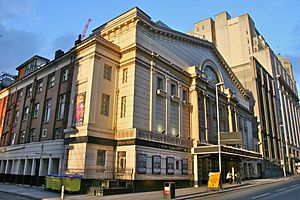
The first theatre in Manchester was the Theatre Royal, opened in 1775. Famous actors like Henry Irving performed on Manchester stages. In the early 1900s, the "Manchester School" was a group of playwrights from Manchester. They included Harold Brighouse, Stanley Houghton, and Allan Monkhouse. Annie Horniman, who owned the Gaiety Theatre, supported them.
Manchester is known for its excellent theatres. Larger venues include the Manchester Opera House on Quay Street. It hosts big touring shows, often from London's West End. The Palace Theatre on Oxford Street is another large venue. The Royal Exchange Theatre is a smaller theatre inside Manchester's old Cotton Exchange. The Lowry Centre in Salford is a large venue for touring shows.
Smaller theatres include the Green Room, which focuses on new and experimental plays. The Contact Theatre is on a university campus and is for young people. The King's Arms Theatre is a theatre and music venue in Salford. The Dancehouse is a theatre just for dance shows.
The city also has two highly respected drama schools: the Manchester Metropolitan University School of Theatre and the Arden School of Theatre. The Royal Northern College of Music (RNCM) has four theatre spaces, especially for opera and classical music. Manchester Theatres provides a guide to the city's theatres.
Sport in Manchester
Sports are a very important part of Manchester's culture. SportCity in east Manchester is a special area for sports. You can find facilities for football, athletics, and cycling there.
Manchester City and Manchester United are popular Premier League football clubs. Manchester United's stadium is actually just outside Manchester's city limits in Trafford.
Even though Manchester has not been part of Lancashire county since 1974, Lancashire County Cricket Club is still based here. It was formed in 1865.
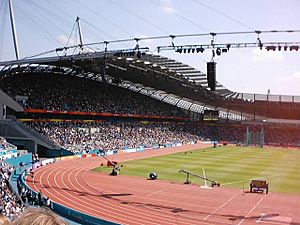
Manchester tried twice to host the Olympic Games. It came in fourth for the 1996 Games and third for the 2000 Games. Instead, Manchester hosted the 2002 Commonwealth Games. Many excellent sports facilities were built for these games. These include the City of Manchester Stadium, the Manchester Velodrome, the National Squash Centre, and the Manchester Aquatics Centre. The 2002 games were a big success. They showed Manchester as a renewed city for the 21st century. They also encouraged London to bid for the 2012 Olympic Games.
Venues in Manchester

Manchester has many venues for performances and conventions, as well as sports:
- City of Manchester Stadium - Home to Manchester City F.C.. This stadium can hold 60,000 people for concerts. It's the second largest after Wembley Stadium in London.
- Manchester Arena - Europe's largest indoor arena.
- Manchester Central - This includes two venues, formerly known as the GMEX Centre and Manchester International Conference Centre.
- Bridgewater Hall
- Manchester Academy
- Manchester Apollo
- Old Trafford Cricket Ground
- The Factory


